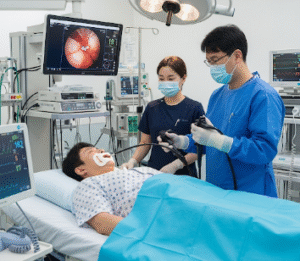Overview
Cholesteatoma is an abnormal skin growth in the middle ear behind the eardrum. Although it is not cancerous, it can be very destructive if left untreated. Over time, it can damage the delicate bones of the middle ear, leading to hearing loss, infections, and even life-threatening complications. In Korea, advanced diagnostic imaging, endoscopic ear surgery, and specialized ENT (ear, nose, and throat) clinics provide effective treatment options for cholesteatoma.
What is Cholesteatoma?
A cholesteatoma is a cyst-like growth made of skin cells and debris that accumulates in the middle ear. It may be congenital (present from birth) or acquired, often developing due to repeated ear infections or poor eustachian tube function. Over time, the mass grows larger, erodes surrounding structures, and interferes with hearing and balance.
Symptoms
- Persistent foul-smelling ear discharge (otorrhea)
- Progressive hearing loss
- Ear pressure or a feeling of fullness
- Dizziness or balance problems
- Ear pain (sometimes)
- Recurrent ear infections
- In severe cases: facial muscle weakness, headaches, or vision changes (due to complications)
Causes
- Chronic ear infections leading to eardrum retraction
- Poor eustachian tube function (causing negative pressure in the middle ear)
- Congenital abnormalities (rare cases present from birth)
- Perforated eardrum or repeated middle ear disease
Risk Factors
- Repeated or untreated middle ear infections
- Chronic sinus or respiratory problems
- Children with eustachian tube dysfunction
- History of ear surgery or trauma
- Family history of chronic ear disease
Complications
If untreated, cholesteatoma can spread and cause serious complications:
- Permanent hearing loss
- Chronic ear infections
- Damage to ossicles (middle ear bones)
- Balance disturbances (vertigo)
- Facial nerve paralysis
- Meningitis, brain abscess, or other life-threatening intracranial infections
Prevention
- Prompt treatment of ear infections
- Regular ear check-ups for people with chronic ear disease
- Avoid inserting objects into the ear
- Early ENT evaluation for persistent ear discharge or hearing loss
Treatment Options in Korea
Korea provides world-class ENT and skull base surgery care, combining minimally invasive techniques with advanced imaging.
1. Diagnosis
- Otoscopy – direct examination of ear canal and eardrum
- Audiometry – to measure hearing loss
- CT scan / MRI – to assess extent and complications
- Culture tests – if recurrent infection is present
2. Medical Treatment
- Antibiotic ear drops or oral antibiotics (for infection control, not a cure)
- Ear cleaning (microsuction) by an ENT specialist
3. Surgical Treatment (Definitive)
- Tympanomastoidectomy – surgical removal of cholesteatoma and infected tissue
- Canal wall up or canal wall down mastoidectomy – depending on severity
- Ossicular chain reconstruction – to restore hearing if ear bones are damaged
- Endoscopic ear surgery – minimally invasive option available in top Korean hospitals
4. Post-Surgery Care
- Regular ENT follow-up (since cholesteatoma can recur)
- Hearing rehabilitation (hearing aids if needed)
- Balance therapy if inner ear was affected













